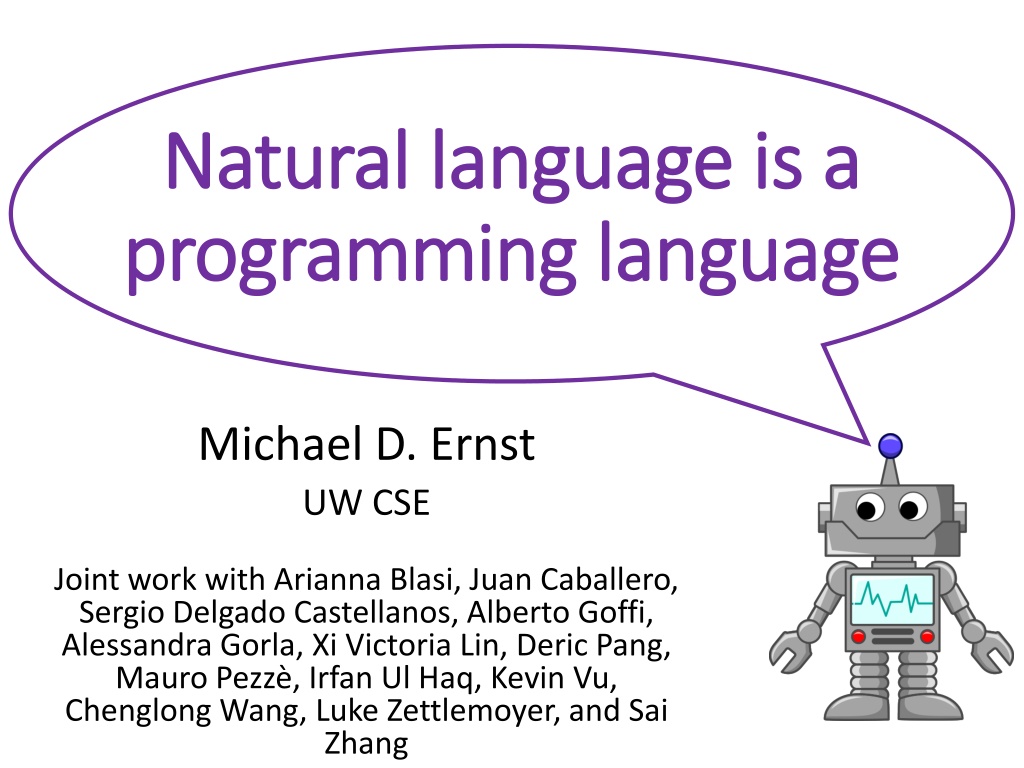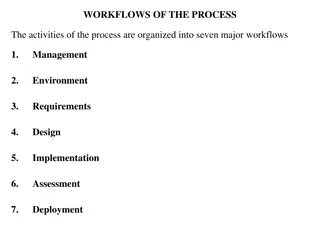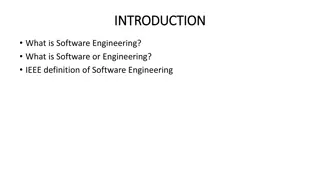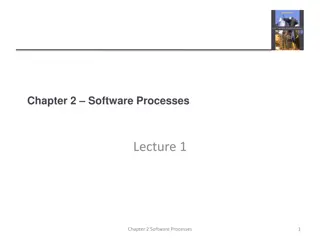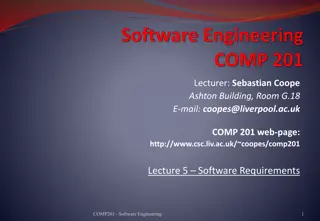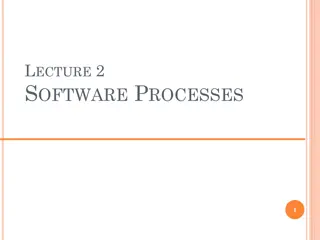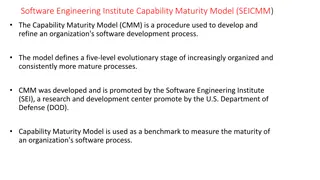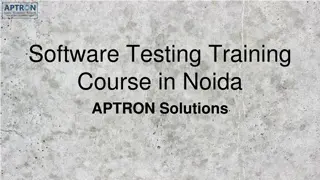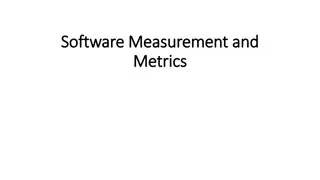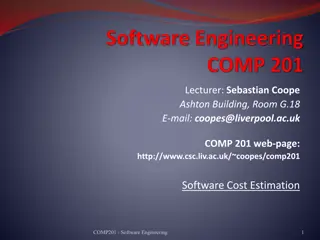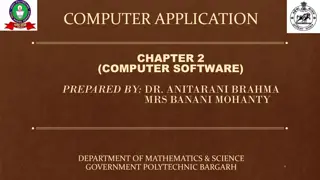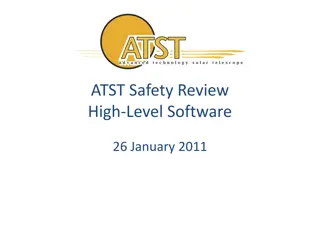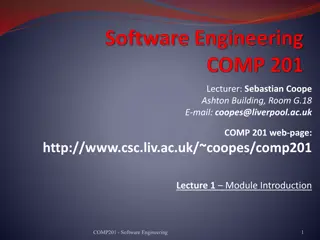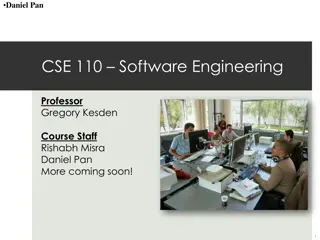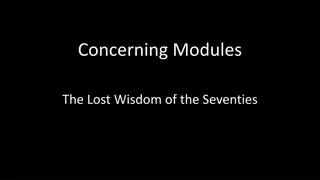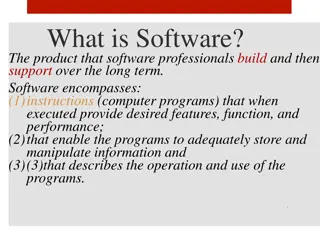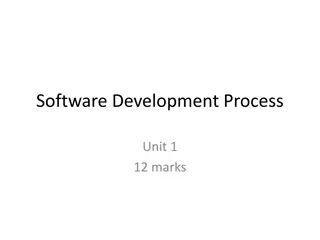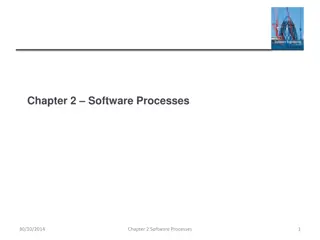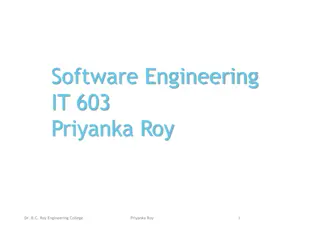Software Development Process
Exploring the definition and components of software, the process of software development, and key aspects such as requirements, programming, documentation, testing, and version control. The images provide insights into natural language programming and the various stages of software development.
Download Presentation

Please find below an Image/Link to download the presentation.
The content on the website is provided AS IS for your information and personal use only. It may not be sold, licensed, or shared on other websites without obtaining consent from the author.If you encounter any issues during the download, it is possible that the publisher has removed the file from their server.
You are allowed to download the files provided on this website for personal or commercial use, subject to the condition that they are used lawfully. All files are the property of their respective owners.
The content on the website is provided AS IS for your information and personal use only. It may not be sold, licensed, or shared on other websites without obtaining consent from the author.
E N D
Presentation Transcript
Natural language is a Natural language is a programming language programming language Michael D. Ernst UW CSE Joint work with Arianna Blasi, Juan Caballero, Sergio Delgado Castellanos, Alberto Goffi, Alessandra Gorla, Xi Victoria Lin, Deric Pang, Mauro Pezz , Irfan Ul Haq, Kevin Vu, Chenglong Wang, Luke Zettlemoyer, and Sai Zhang
Questions about software Questions about software How many of you have used software? How many of you have written software?
What is software? What is software?
What is software? What is software? A sequence of instructions that perform some task
What is software? What is software? An engineered object amenable to formal analysis A sequence of instructions that perform some task
What is software? What is software? A sequence of instructions that perform some task
What is software? What is software? A sequence of instructions that perform some task
What is software? What is software? A sequence of instructions that perform some task Test cases Version control history Issue tracker Documentation How should it be analyzed?
Programming Requirements Discussions Models Issue tracker Specifications User stories Documentation Version control Programs Process Architecture Tests
Programming Requirements Discussions Models Issue tracker Specifications User stories Documentation Programs Version control PL Structure Process Architecture Documentation Output strings Tests Variable names
Programming Requirements Discussions Models Issue tracker Specifications User stories Documentation Programs Version control PL Structure Process Architecture Documentation Output strings Tests Variable names
Programming Requirements Discussions Models Issue tracker Specifications User stories Documentation Programs Version control PL Structure Process Architecture Documentation Output strings Tests Variable names
Programming Requirements Discussions Models Issue tracker Specifications User stories Documentation Programs Version control PL Structure Process Architecture Documentation Output strings Tests Variable names
Analysis of a natural object Analysis of a natural object Machine learning over executions Version control history analysis Bug prediction Upgrade safety Prioritizing warnings Program repair
Specifications are needed; Specifications are needed; Tests are available but ignored Tests are available but ignored Specs are needed. Many papers start: Given a program and its specification Tests are ignored. Formal verification process: Write the program Test the program Verify the program, ignoring testing artifacts Observation: Programmers embed semantic info in tests Goal: translate tests into specifications Approach: machine learning over executions
Dynamic detection Dynamic detection of likely invariants of likely invariants https://plse.cs.washington.edu/daikon/ [ICSE 1999] Observe values that the program computes Generalize over them via machine learning Result: invariants (as in asserts or specifications) x > abs(y) x = 16*y + 4*z + 3 array a contains no duplicates for each node n,n=n.child.parent graph g is acyclic Unsound, incomplete, and useful
Programming Requirements Discussions Models Issue tracker Specifications User stories Documentation Programs Version control PL Structure Process Architecture Documentation Output strings Variable names Tests
Programming Requirements Discussions Models Issue tracker Specifications User stories Documentation Programs Version control PL Structure Process Architecture Documentation Output strings Variable names Tests
Programming Requirements Discussions Models Issue tracker Specifications User stories Documentation Programs Version control PL Structure Process Architecture Documentation Output strings Variable names Tests
Applying NLP to software engineering Applying NLP to software engineering Problems NL sources NLP techniques inadequate diagnostics error messages document similarity Analyze existing code incorrect operations variable names word semantics missing tests code comments parse trees Generate new code unimplemented functionality user questions translation
Applying NLP to software engineering Applying NLP to software engineering Problems NL sources NLP techniques inadequate diagnostics error messages document similarity [ISSTA 2015] incorrect operations variable names word semantics missing tests code comments parse trees unimplemented functionality user questions translation
Inadequate diagnostic messages Inadequate diagnostic messages Scenario: user supplies a wrong configuration option --port_num=100.0 Problem: software issues an unhelpful error message unexpected system failure unable to establish connection Hard for end users to diagnose Goal: detect such problems before shipping the code Better message: --port_num should be an integer
Challenges for proactive detection Challenges for proactive detection of inadequate diagnostic messages of inadequate diagnostic messages How to triggera configuration error? How to determine the inadequacy of a diagnostic message?
ConfDiagDetectors solutions ConfDiagDetector s solutions How to triggera configuration error? Configuration mutation + run system tests + failed tests triggered errors (We know the root cause.) configuration system tests How to determine the inadequacy of a diagnostic message? Use a NLP technique to check its semantic meaning Similar semantic meanings? Diagnostic messages output by failed tests User manual (Assumption: a manual, webpage, or man page exists.)
When is a message adequate? When is a message adequate? Contains the mutated option nameor value [Keller 08, Yin 11] Mutated option: --percentage-split Diagnostic message: the value of percentage-split should be > 0 Similar semantic meaning as the manual description Mutated option: --fnum Diagnostic message: Number of folds must be greater than 1 User manual description of --fnum: Sets number of folds for cross-validation
Classical document similarity: Classical document similarity: TF TF- -IDF + cosine similarity IDF + cosine similarity 1. Convert document into a real-valued vector 2. Document similarity = vector cosine similarity Vector length = dictionary size, values = term frequency (TF) Example: [2 classical, 8 document, 3 problem, 3 values, ] Problem: frequent words swamp important words Solution: values = TF x IDF (inverse document frequency) IDF = log(total documents / documents with the term) Problem: does not work well on very short documents
Text similarity technique Text similarity technique [Mihalcea 06] Manual description A message The documents have similar semantic meanings if many words in them have similar meanings Example: The program goes wrong 1. 2. Remove all stop words. For each word in the diagnostic message, try to find similar words in the manual. Two sentences are similar, if many words are similar between them. The software fails 3.
Results Results Reported 25 missing and 18 inadequate messages in Weka, JMeter, Jetty, Derby Validation by 3 programmers: 0% false negative rate Tool says message is adequate, humans say it is inadequate 2% false positive rate Tool says message is inadequate, humans say it is adequate Previous best: 16%
Related work Related work Configuration error diagnosis techniques Dynamic tainting [Attariyan 08], static tainting [Rabkin 11], Chronus [Whitaker 04] Troubleshooting an exhibited error rather than detecting inadequate diagnostic messages Software diagnosability improvement techniques PeerPressure [Wang 04], RangeFixer [Xiong 12], ConfErr [Keller 08] and Spex-INJ [Yin 11], EnCore [Zhang 14] Requires source code, usage history, or OS-level support
Applying NLP to software engineering Applying NLP to software engineering Problems NL sources NLP techniques inadequate diagnostics error messages document similarity incorrect operations variable names word semantics [WODA 2015] missing tests code comments parse trees unimplemented functionality user questions translation
Undesired variable interactions Undesired variable interactions int totalPrice; int itemPrice; int shippingDistance; totalPrice = itemPrice + shippingDistance; The compiler issues no warning A human can tell the abstract types are different Idea: Cluster variables based on usage in program operations Cluster variables based on words in variable names Differences indicate bugs or poor variable names
Undesired variable interactions Undesired variable interactions int totalPrice; int itemPrice; int shippingDistance; totalPrice = itemPrice + shippingDistance; The compiler issues no warning A human can tell the abstract types are different Idea: Cluster variables based on words in variable names Cluster variables based on usage in program operations Differences indicate bugs or poor variable names
Undesired interactions Undesired interactions distance itemPrice tax_rate miles shippingFee percent_complete
Undesired interactions Undesired interactions distance itemPrice + distance itemPrice tax_rate miles shippingFee percent_complete
Undesired interactions Undesired interactions float int distance itemPrice tax_rate miles shippingFee percent_complete Program types don t help
Undesired interactions Undesired interactions distance itemPrice tax_rate miles shippingFee percent_complete Language indicates the problem
Variables Variables
Variable clustering Variable clustering Cluster based on interactions: operations
Variable clustering Variable clustering Cluster based on language: variable names
Variable clustering Variable clustering Cluster based on interactions: operations Cluster based on language: variable names Problem Actual algorithm: 1. Cluster based on operations 2. Sub-cluster based on names 3. Rank an operation cluster as suspicious if it contains well-defined name sub-clusters
Clustering based on Clustering based on operations operations Abstract type inference [ISSTA 2006] int totalCost(int miles, int price, int tax) { int year = 2016; if ((miles > 1000) && (year > 2000)) { int shippingFee = 10; return price + tax + shippingFee; } else { return price + tax; } }
Clustering based on Clustering based on operations operations Abstract type inference [ISSTA 2006] int totalCost(int miles, int price, int tax) { int year = 2016; if ((miles > 1000) && (year > 2000)) { int shippingFee = 10; return price + tax + shippingFee; } else { return price + tax; } }
Clustering based on Clustering based on variable names variable names Compute variable name similarity for var1 and var2 1. Tokenize each variable into dictionary words in_authskey15 { in , authentications , key } Expand abbreviations, best-effort tokenization 2. Compute word similarity For all w1 var1 and w2 var2, use WordNet (or edit distance) 3. Combine word similarity into variable name similarity maxwordsim(w1, var2) = max wordsim(w1, w2) w2 var2 varsim(var1, var2) = average maxwordsim(w1, var2) w1 var1
Results Results Ran on grep and Exim mail server Top-ranked mismatch indicates an undesired variable interaction in grep if (depth < delta[tree->label]) delta[tree->label] = depth; Loses top 3 bytes of depth Not exploitable because of guards elsewhere in program, but not obvious here
Related work Related work Reusing identifier names is error-prone [Lawrie 2007, Deissenboeck 2010, Arnaoudova 2010] Identifier naming conventions [Simonyi] Units of measure [Ada, F#, etc.] Tokenization of variable names [Lawrie 2010, Guerrouj 2012]
Applying NLP to software engineering Applying NLP to software engineering Problems NL sources NLP techniques inadequate diagnostics error messages document similarity incorrect operations variable names word semantics missing tests code comments parse trees [ISSTA 2016] unimplemented functionality user questions translation
Test oracles ( Test oracles (assertstatements) statements) A test consists of an input (for a unit test, a sequence of calls) an oracle (an assertstatement) Programmer-written tests often trivial oracles, or too few tests Automatic generation of tests: inputs are easy to generate oracles remain an open challenge Goal: create test oracles from what programmers already write
Automatic test generation Automatic test generation Code under test: public class FilterIterator implements Iterator { public FilterIterator(Iterator i, Predicate p) { } public Object next() { } } * the iterator or predicate are null */ /** @throws NullPointerException if either Automatically generated test: public void test() { FilterIterator i = new FilterIterator(null, null); i.next(); } Did the tool discover a bug? Throws NullPointerException! It could be: 1. Expected behavior 2. Illegal input 3. Implementation bug
Automatically Automatically generated generated tests tests A test generation tool outputs: Failing tests indicates a program bug Passing tests useful for regression testing Without a specification, the tool guesses whether a given behavior is correct False positives: report a failing test that was due to illegal inputs False negatives: fail to report a failing test because it might have been due to illegal inputs
Programmers write code comments Programmers write code comments Javadoc is standard procedure documentation /** * Checks whether the comparator is now * locked against further changes. * * @throws UnsupportedOperationException * if the comparator is locked */ protected void checkLocked() {...}
